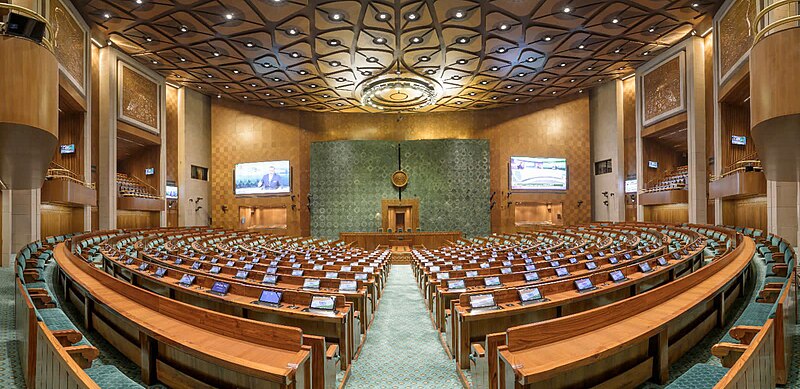Indian law students are reporting for JURIST on law-related developments in and affecting India. Samar Veer is JURIST’s Dispatches Managing Editor and a law student at National Law University, Delhi.
After several decades of being a dead letter, the Parliament of India has passed a long-debated bill that reserves a specific portion of seats for women in the Lok Sabha (lower house of Parliament) and the state legislative assemblies.
The Constitution (One Hundred and Sixth Amendment) Act received the assent of the President of India at the end of September and is now law. However, to actually implement the bill’s proposed reforms (discussed below), an exercise of delimitation is to be undertaken. Union Home Minister Amit Shah has mentioned that the exercise will be undertaken soon after the approaching 2024 Lok Sabha Elections, by 2026. Delimitation is the process of revising the boundaries of constituencies to which candidates are elected as Members of Parliament (MPs), in order to accurately reflect any changes in population over the years. Within this scheme of reserving seats, there are further provisions for reserving seats for women belonging to Scheduled Castes and Scheduled Tribes (marginalized castes and tribes recognised under the Constitution).
The Bill is a culmination of a decades-long debate that had previously reached a fever pitch in 2008 when the Women’s Reservation Bill (2008) was introduced in Parliament but had failed to gather enough support. The current bill reflects a seventh, and finally successful attempt to implement the reservation policy. Notably, there already exist reservations to the tune of 33% of total seats at the grassroots level in India. Panchayats (an elected body of five individuals at the local level who often arbitrate disputes) have such reservations, which were introduced as constitutional amendments in the form of the 73rd 7and 74th Constitution (Amendment) Acts. There have been positive effects noted in the form of increased women’s participation in local politics, in addition to helping normalise women’s roles in the public sphere in rural India, which is still heavily dominated by patriarchal systems of organisation in a variety of fields, from politics to education and domestic affairs. The Bill has witnessed broad bipartisan support, with near-unanimous voting in favour, with only two votes against it and 454 in favour in Lok Sabha, and no votes against it in Rajya Sabha (Upper House of Parliament). This Act is expected to considerably enhance the number of women in the upper echelons of Indian politics. Currently, only about 14 percent of lawmakers in the Lower House are women. This is considerably below the current global average of 26.5 percent.
There had been various questions raised over the Bill. Some Opposition MPs in the House had initially raised the point of having to conduct a delimitation exercise and expressed apprehensions of potentially delayed implementation. However, such concerns seem to have largely been allayed after the guarantee of conducting delimitation post-elections by the Home Minister. Further questions involve the lack of a quota for OBC (Other Backward Castes) women, who also represent a significant and diverse proportion of India’s population. A Joint Parliamentary Committee, which had examined a similar proposal for reserving seats for women, had recommended such a measure to ensure the representation of OBCs proportionately. There already exist reservations in educational institutions for SC, SC and OBC individual. The same is however, not reflected here.
The new Act also provides that it shall last for a term of 15 years, after which it will be subject to review by parliament for further extensions, similar to how the SC/ST reservation policies are extended via periodic constitutional amendments by Parliament.
While it is encouraging to see that concrete measures are being adopted by the highest lawmaking body of the land to further women’s participation in politics, concerns exist. While in line with enshrined constitutional principles as per Article 243D of the Constitution (which mandates reservations in Panchayats), there have been questions raised by the Opposition regarding other issues (in the current debate and in previous ones) about the delays in implementation and a lack of OBC quotas.
Another major question to consider within all this pertains to the distribution of women-only constituencies. The Act mandates that constituencies reserved for women will be rotated after every delimitation exercise, which is usually ten years. This would mean that at varying points of time in the future, a certain portion of constituencies will be declared women-only for the next ten years, and after that period, they would return to being general constituencies, while another portion of constituencies will be reserved for the next decade. A problem with this lies in the possibility that if a certain legislator is elected from a constituency, and their constituency is to be declared reserved for women in the near future, said legislator might become ineligible for re-election for another term. The absence of any chance at re-election would considerably reduce the impetus a legislator has to do meaningful development work in their constituency. The possibility of losing elections is still a major driving force that compels legislators to work for the betterment of their constituency. The rotational model may eliminate that incentive.
Broadly, the step is seen as largely positive by opposition and ruling party legislators. The effects of women’s reservation have had demonstrably positive effects on their empowerment. Whether the 108th Amendment manages to replicate that success at the national level remains to be seen.


